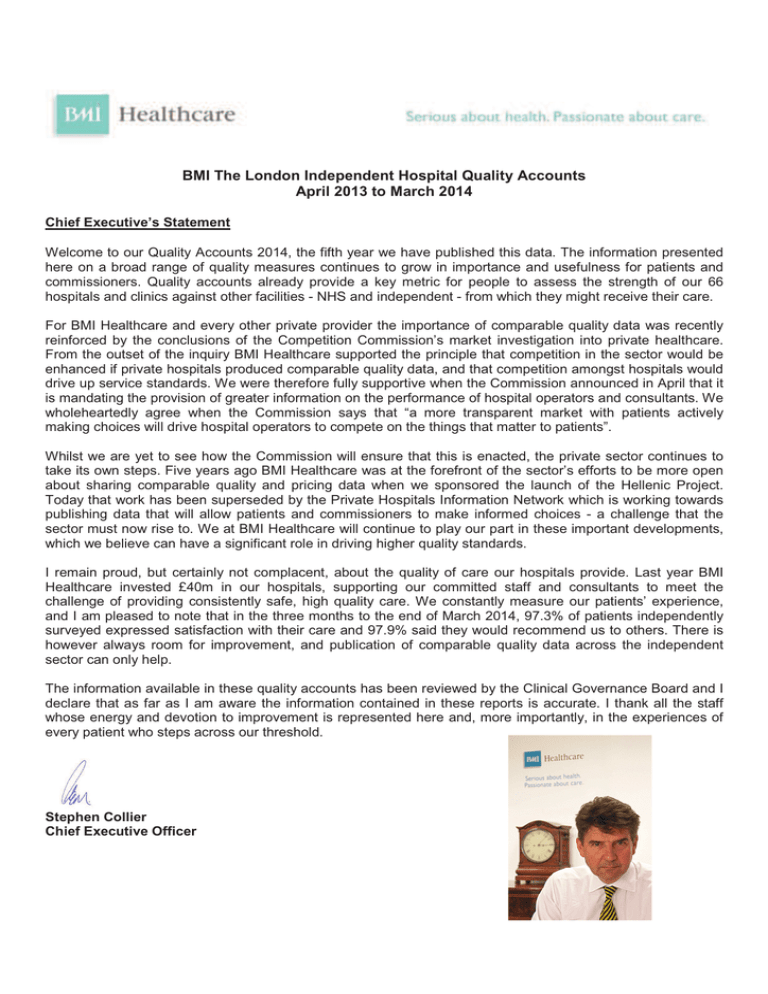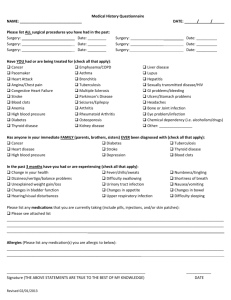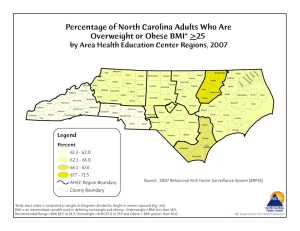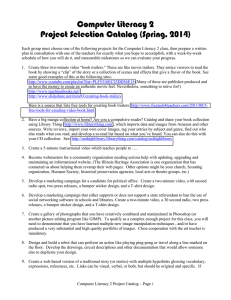
BMI The London Independent Hospital Quality Accounts
April 2013 to March 2014
Chief Executive’s Statement
Welcome to our Quality Accounts 2014, the fifth year we have published this data. The information presented
here on a broad range of quality measures continues to grow in importance and usefulness for patients and
commissioners. Quality accounts already provide a key metric for people to assess the strength of our 66
hospitals and clinics against other facilities - NHS and independent - from which they might receive their care.
For BMI Healthcare and every other private provider the importance of comparable quality data was recently
reinforced by the conclusions of the Competition Commission’s market investigation into private healthcare.
From the outset of the inquiry BMI Healthcare supported the principle that competition in the sector would be
enhanced if private hospitals produced comparable quality data, and that competition amongst hospitals would
drive up service standards. We were therefore fully supportive when the Commission announced in April that it
is mandating the provision of greater information on the performance of hospital operators and consultants. We
wholeheartedly agree when the Commission says that “a more transparent market with patients actively
making choices will drive hospital operators to compete on the things that matter to patients”.
Whilst we are yet to see how the Commission will ensure that this is enacted, the private sector continues to
take its own steps. Five years ago BMI Healthcare was at the forefront of the sector’s efforts to be more open
about sharing comparable quality and pricing data when we sponsored the launch of the Hellenic Project.
Today that work has been superseded by the Private Hospitals Information Network which is working towards
publishing data that will allow patients and commissioners to make informed choices - a challenge that the
sector must now rise to. We at BMI Healthcare will continue to play our part in these important developments,
which we believe can have a significant role in driving higher quality standards.
I remain proud, but certainly not complacent, about the quality of care our hospitals provide. Last year BMI
Healthcare invested £40m in our hospitals, supporting our committed staff and consultants to meet the
challenge of providing consistently safe, high quality care. We constantly measure our patients’ experience,
and I am pleased to note that in the three months to the end of March 2014, 97.3% of patients independently
surveyed expressed satisfaction with their care and 97.9% said they would recommend us to others. There is
however always room for improvement, and publication of comparable quality data across the independent
sector can only help.
The information available in these quality accounts has been reviewed by the Clinical Governance Board and I
declare that as far as I am aware the information contained in these reports is accurate. I thank all the staff
whose energy and devotion to improvement is represented here and, more importantly, in the experiences of
every patient who steps across our threshold.
Stephen Collier
Chief Executive Officer
Hospital Information
%0,7KH/RQGRQ,QGHSHQGHQW+RVSLWDOLVDFRPSUHKHQVLYHDFXWHSULYDWHKRVSLWDOORFDWHGFORVHWRWKH&LW\RI/RQGRQ
DQG &DQDU\ :KDUI DQG LV ZLWKLQ HDV\ DFFHVV RI (VVH[ DQG WKH KRPH FRXQWLHV )RU RYHU \HDUV 7KH /RQGRQ
,QGHSHQGHQW KDV UHPDLQHG DW WKH IRUHIURQW RI SULYDWH KHDOWKFDUH DW WKH KLJKHVW GHJUHH RI FRPSOH[LW\ DV ZHOO DV
GHOLYHULQJDYDVWDUUD\RIURXWLQHWUHDWPHQWVIRUSDWLHQWVZKRVHHNLQWHUQDWLRQDOO\UHQRZQHGH[SHUWLVH
$WWUDFWLQJUHIHUUDOVZRUOGZLGHRXUVSHFLDOLVWFRQVXOWDQWVVHHSDWLHQWVDFURVVDEURDGUDQJHRIVSHFLDOWLHVLQFOXGLQJ
FDUGLRORJ\ FDUGLDF VXUJHU\ QHXURVXUJHU\ EDULDWULF VXUJHU\ 2UWKRSDHGLF VXUJHU\ VSRUWV DQG H[HUFLVH PHGLFLQH
JHQHUDOVXUJHU\FRPSOH[UHFRQVWUXFWLYHVXUJHU\JDVWURHQWHURORJ\XURORJ\DQG*\QDHFRORJ\
+RPHWRRQHRIWKHPRVWHVWHHPHGWHDPVRIFRQVXOWDQWFDUGLRORJLVWVDQGFDUGLRWKRUDFLFVXUJHRQVLQWKHFRXQWU\
WKH KRVSLWDO KDV ORQJ EHHQ D FRUH FHQWUH IRU FDUGLDF FDUH :H DWWUDFW UHIHUUDOV ERWK QDWLRQDOO\ DQG LQWHUQDWLRQDOO\
EDVHGRQERWKWKHH[SHUWLVHRIRXUFRQVXOWDQWVDQGFDUGLDFQXUVLQJWHDPVWRJHWKHUZLWKRXUDELOLW\WRFRYHUHYHU\
DVSHFWRIWKHSDWLHQWSDWKZD\
.H\IDFLOLWLHVLQFOXGH
•
•
•
•
•
•
FRQVXOWLQJURRPVLQFOXGLQJDWUHDWPHQWURRP
RSHUDWLQJWKHDWUHV
GHGLFDWHG2UWKRSDHGLFVWKHDWUHVZLWKODPLQDUIORZDQWLLQIHFWLRQV\VWHP
'HGLFDWHGFDUGLDFWKHDWUHDQGFDUGLDFFDWKHWHULVDWLRQVXLWH
(QGRVFRS\WKHDWUH
,QSDWLHQW DQG SULYDWH GD\ FDUH ZDUG FRPSULVLQJ FRPIRUWDEOH SULYDWH URRPV DOO ZLWK HQVXLWH EDWKURRP
VDWHOOLWH79:LILWHOHSKRQHPLQLIULGJHDQGHOHFWURQLFDOO\FRQWUROODEOHEHGDQGOLJKWLQJ
•
•
•
•
•
•
EHGGD\VXUJHU\ZDUGGHGLFDWHGWR1+6GD\VXUJHU\SDWLHQWV
EHG,QWHQVLYH&DUH8QLW
EHG+LJK'HSHQGHQF\8QLW
$GYDQFHGSULYDWHLPDJLQJXQLWLQFOXGLQJVOLFH&705,QXFOHDULPDJLQJDQGHFKRFDUGLRJUDSK\
3K\VLRWKHUDS\GHSDUWPHQWLQFOXGLQJKLJKO\VSHFLILHGJ\PDQGDODUJHWHDPRIVSHFLDOLVWSK\VLRWKHUDSLVWV
2QVLWHSDWKRORJ\XQLWIRUUDSLGWHVWUHVXOWV
This year The London Independent Hospital gained Human Tissue Act accreditation and successfully carried
out its first live kidney donor transplant operation.
The hospital’s consulting rooms suite was completely refurbished with capacity increased from 10 to 20
consulting rooms with a dedicated pre-assessment team ensuring pre-assessment for all patients.
The main reception and imaging department reception areas were also completely refurbished.
The London Independent Hospital is planning to relocate and refurbish the endoscopy facility to the ground
floor. The new unit will be fully JAG compliant to enable JAG accreditation. The build project is due to start in
July 2014 and be completed by December 2014.
The London Independent Hospital has developed cranial neurosurgery services.
The London Independent Hospital has developed dialysis as a therapeutic support for our medical and surgical
referrals with renal replacement requirements.
We have recently commissioned a 3 bed high dependency unit to support the existing 6 bed intensive care
unit.
We have expanded the capacity of our medical records department to enable us to maintain comprehensive
medical records for all outpatients as well as inpatients.
In 2013 our Cath Lab Manager won the prestigious Nursing Times Award of Nurse of the Year. This has never
before been won by a nurse within the private sector and is something we are immensely proud of.
Within The London Independent Hospital, 40% of its caseload is NHS work. The split between Spot and
choose and book is 516 cases & 2187 cases respectively.
For choose and book the specialties contributing the majority of the cases are Orthopaedics (691), General
Surgery (643) & Neurosurgery (254). For Spot it is mainly Orthopaedics (222) and General Surgery (186).
BMI Healthcare are registered as a provider with the Care Quality Commission (CQC) under the Health &
Social Care Act 2008. BMI The London Independent Hospital is registered as a location for the following
regulated services:•
•
•
Treatment of disease, disorder and injury
Surgical procedures
Diagnostic and screening procedures
The CQC carried out an unannounced inspection on 21 February 2014 and found compliant in the following
areas:
Respecting and involving people who use services
Consent to care and treatment
Cooperating with other providers
Safeguarding people who use services from abuse
Staffing
Complaints
During the inspection The London Independent Hospital was found to be non-compliant in one area:
Care and welfare of people who use services
X
An action plan was submitted appropriately and all remedial actions are now being carried out and the CQC
are due to return to check and discuss our progress.
The London Independent Hospital has a local framework through which clinical effectiveness, clinical incidents
and clinical quality is monitored and analysed. Where appropriate, action is taken to continuously improve the
quality of care. This is through the work of a multidisciplinary group and the Medical Advisory Committee.
Regional Clinical Quality Assurance Groups monitor and analyse trends and ensure that the quality
improvements are operationalised.
At corporate level the Clinical Governance Board has an overview and provides the strategic leadership for
corporate learning and quality improvement.
There has been ongoing focus on robust reporting of all incidents, near misses and outcomes. Data quality
has been improved by ongoing training and database improvements. New reporting modules have increased
the speed at which reports are available and the range of fields for analysis. This ensures the availability of
information for effective clinical governance with implementation of appropriate actions to prevent recurrences
in order to improve quality and safety for patients, visitors and staff.
At present we provide full, standardised information to the NHS, including coding of procedures, diagnoses and
co-morbidities and PROMs for NHS patients.There are additional external reporting requirements for CQC,
Public Health England (Previously HPA) CCGs and Insurers
BMI is a founding member of the Private Healthcare Information Network (PHIN) UK – where we produce a
data set of all patient episodes approaching HES-equivalency and submit this to PHIN for publication. The data
is made available to common standards for inclusion in comparative metrics, and is published on the PHIN
website http://www.phin.org.uk. This website gives patients information to help them choose or find out more
about an independent hospital including the ability to search by location and procedure.
1. Safety
1.1 Infection prevention and control
The focus on infection prevention and control continues under
leadership of the Group Head of Infection Prevention and
in liaison with the link nurse in The London Independent
Hospital.
the
Control,
The focus on infection prevention and control continues under
leadership of the Group Director of Infection Prevention and
and Group Head of Infection Prevention and Control, in liaison
Infection Prevention and Control Lead at The London
Independent Hospital.
the
Control
with the
We have had: • Zero cases of MRSA bacteraemia in the last year (NHS
1.17cases/100,000 bed days).
• Zero MSSA bacteraemia cases /100,000 bed days
• Zero E.coli bacteraemia cases/ 100,000 bed days
• Zero of hospital apportioned Clostridium difficile in the last 12 months.
• SSI data is also collected and submitted to Public Health England for Orthopaedic surgical procedures.
Our rates of infection are;
o Hips
o Knees
+LSV
6LWHV
5LVN
/RQGRQ,QGHSHQGHQW
+RVSLWDO
.QHHV
5LVN 5LVN
5LVN
5LVN
5LVN
5LVN 5LVN
The London Independent Hospital use care bundles as a means of documenting interventions in the areas of:
•
•
•
•
Surgical site care
Urinary catheter care
Intravenous Peripheral Lines
Surgical site infections
The above care bundles have been implemented at the London Independent Hospital, compliance is
monitored by the Infection Control links and appropriate interventions recommended at times where necessary.
Good compliance generally, an improvement noted in documentation and the MRSA risk assessment form has
been updated as a result of the audits.
All departments have an environmental audit completed annually and appropriate actions taken to ensure
compliance.
Infection control audits are completed monthly as part of a rolling corporate programme, with different themes
each month, for example waste management, Isolation Nursing and facilities, Surveillance, Equipment
cleansing, and Sharps management, with compliance averaging 92 %.
All clinical staff undergo training and assessment in ANTT [Aseptic Non Touch Technique] for clinical
interventions and all staff that have contact with patients complete an annual hand hygiene competency.
Environmental cleanliness is also an important factor in infection prevention and our patients rate the
cleanliness of our facilities highly.
Environmental cleanliness is also an important factor in infection prevention and our patients rate the
cleanliness of our facilities highly.
1.2 Patient Led Assessment of the Care Environment (PLACE)
We believe a patient should be cared for with compassion and dignity in a clean, safe environment. Where
standards fall short, they should be able to draw it to the attention of managers and hold the service to account.
PLACE assessments will provide motivation for improvement by providing a clear message, directly from patients,
about how the environment or services might be enhanced.
In 2013 we introduced PLACE, which is the new system for assessing the quality of the patient environment,
replacing the old Patient Environment Action Team (PEAT) inspections.
The assessments involve patients and staff who assess the hospital and how the environment supports patient’s
privacy and dignity, food, cleanliness and general building maintenance. It focuses entirely on the care environment
and does not cover clinical care provision or how well staff are doing their job.
The results will show how hospitals are performing nationally and locally.
PLACE 2013 Audit results for London Independent
Cleanliness:
Condition, appearance and maintenance:
Privacy, Dignity and Wellbeing:
Food:
95.3% vs national average of 95.7%
87.85% vs national average of 88.75%
90.17% vs national average of 88.87%
88.08% vs national average of 84.98%
The specific areas that scored less well in the 2013 audit in terms of condition, appearance and maintenance
were consulting rooms, main reception and imaging reception and these areas have all been completely
refurbished following the audit.
Several changes were made to the patient menus including better signposting of healthy dishes and spice
levels and the choices of side dishes has been made clearer.
1.3 Venous Thrombo-embolism (VTE)
BMI Healthcare, holds VTE Exemplar Centre status by the Department of Health across its whole network of
hospitals including, The London Independent Hospital. BMI Healthcare was awarded the Best VTE Education
Initiative Award category by Lifeblood in February 2013 and were the Runners up in the Best VTE Patient
Information category.
We see this as an important initiative to further assure patient safety and care. We audit our compliance with
our requirement to VTE risk assessment every patient who is admitted to our facility and the results of our audit
on this has shown consistent compliance at 100%.
The London Independent Hospital reports the incidence of Venous Thromboembolism (VTE) through the
corporate clinical incident system. It is acknowledged that the challenge is receiving information for patients
who may return to their GPs or other hospitals for diagnosis and/or treatment of VTE post discharge from the
Hospital. As such we may not be made aware of them. We continue to work with our Consultants and referrers
in order to ensure that we have as much data as possible.
In the last 12 months we have had one reported pulmonary embolism. A full root cause analysis was
undertaken. The patient who sustained the pulmonary embolism had undergone complex spinal surgery the
nature of which precluded the use of pharmacological prophylaxis due to a high bleeding risk. Mechanical
prophylaxis was used appropriately.
2. Effectiveness
2.1 Patient reported Outcomes (PROMS)
Patient Reported Outcome Measures (PROMs) are a means of collecting information on the effectiveness of
care delivered to NHS patients as perceived by the patients themselves. PROMs is a Department of Health led
programme.
Latest results can be found by going on the online SOLAR system provided to you by Quality Health
For the current reporting period, the tables below demonstrate that the health gain between Questionnaire 1
(pre-operative) and Questionnaire 2 (post–operative) for patients undergoing hip replacement and knee
replacement at The London Independent Hospital.
Oxford Hip Score average
2013
Q1
London
Independent
Hospital
Q2
Health gain (Q2 - Q1 average)
35.667
19.5
0.767
0.429
16.167
0.339
England
Copyright © 2011 Re-used with the permission of The Health and Social Care Information Centre. All rights reserved.'
Oxford Knee Score average
2013
Q1
Q2
Health gain (Q2 - Q1 average)
*
*
*
0.387
0.709
0.321
London
Independent
Hospital
England
Copyright © 2013, The Health and Social Care Information Centre. All Rights Reserved.
• *Less than 30 patients went through the process therefore site cannot be scored
2.2 Enhanced Recovery Programme (ERP)
The ERP is about improving patient outcomes and speeding up a patient’s recovery after surgery. ERP
focuses on making sure patients are active participants in their own recovery and always receive evidence
based care at the right time. It is often referred to as rapid recovery, is a new, evidence-based model of care
that creates fitter patients who recover faster from major surgery. It is the modern way for treating patients
where day surgery is not appropriate.
ERP is based on the following principles:1. All Patients are on a pathway of care
a. Following best practice models of evidenced based care
b. Reduced length of stay
2. Patient Preparation
a. Pre Admission assessment undertaken
b. Group Education sessions
c. Optimizing the patient prior to admission – i.e HB optimisation, control co-morbidities,
medication assessment – stopping medication plan.
d. Commencement of discharge planning
3. Proactive patient management
a. Maintaining good pre-operative hydration
b. Minimising the risk of post-operative nausea and vomiting
c. Maintaining normothermia pre and post operatively
d. Early mobilisation
4. Encouraging patients have an active role in their recovery
a. Participate in the decision making process prior to surgery
b. Education of patient and family
c. Setting own goals daily
d. Participate in their discharge planning
The enhanced recovery programme at the London Independent has resulted in the following improvements to
average length of stay for NHS patients following hip and knee replacement surgery.
<ŶĞĞZĞƉůĂĐĞŵĞŶƚ
ϮϬϭϭͲϮϬϭϮ
ϮϬϭϯ
ϰ͘ϳ
ϯ͘ϰ
dŽƚĂů,ŝƉZĞƉůĂĐĞŵĞŶƚ>ŽŶĚŽŶ/ŶĚĞƉĞŶĚĞŶƚs>K^
,ŝƉZĞƉůĂĐĞŵĞŶƚ
ϮϬϭϭͲϮϬϭϮ
ϮϬϭϯ
ϲ͘ϭ
ϯ͘ϭ
2.3 Unplanned Readmissions within 31 days and unplanned returns to theatre.
Unplanned readmissions and unplanned returns to theatre are normally due to a clinical complication related to
the original surgery.
London Independent Hospital
Unplanned readmission within Unplanned returns to theatre
31 days
8
5
Patients for both readmission and returns to theatre are showing no particular trends. Variety of genuine
clinical reasons for both readmission or the return to theatre over a variety of surgical specialties.
3. Patient experience
3.1 Patient satisfaction
BMI Healthcare is committed to providing the highest levels of quality of care to all of our patients. We
continually monitor how we are performing by asking patients to complete a patient satisfaction questionnaire.
Patient satisfaction surveys are administered by an independent third party.
The table below shows The London Independent Hospital’s results from 2012 and 2013 for patients who
responded as their categories to be either good, very good or excellent.
Admission Process
Overall Nursing Care
Accommodation
Catering
Departure Process
Overall Quality of Care
Results From Jan-Dec 2012
98.6%
99.3%
98.9%
96.7%
97.6%
99.4%
Results From Jan-Dec 2013
91.9%
95.2%
92.6%
85.2%
89.6%
96.0%
Our scores declined in 2013 but it is probably that this was because we became a pilot site for a new postcard
survey for our patient satisfaction results and scoring system. This did not prove positive and has now been
discarded by BMI Healthcare. We are now starting to see an increase in our scores by using the quesionnaire
system.
We are constantly monitoring our results and actively take on board the comments made by the patients and
seek ways to improve our services where necessary.
3.2 Complaints
In addition to providing all patients with an opportunity to complete a satisfaction survey BMIThe London
Independent Hospital actively encourages feedback both informally and formally. Patients are supported
through a robust complaints procedure, operated over three stages:
Stage 1: Hospital resolution
Stage 2: Corporate resolution
Stage 3: Patients can refer their complaint to independent adjudication if they are not satisfied with the
outcome at the other 2 stages.
London Independent Hospital
Written Complaints
100
We review our complaints on a regular basis and include our staff and consultants where necessary in order to
improve our service. Overall we have made improvements to many departments, in particular with outpatients
by relocating and refurbishing the area and increasing our staffing levels to provide a better service.
Less than 1% of our total complaints are escalated to stage 2 level. We did have one patient who referred his
complaint to the Ombudsman for review. The review has now been completed and was partially upheld in
March 2014. An action plan has been drawn up surrounding this complaint and we are working to improve the
issues listed on the plan. We are to review in September 2014.
4. CQUINS
The Commissioning for Quality and Innovation (CQUINs) framework was set up in 2009/2010 to encourage
care providers to share and continually improve how care is delivered and to achieve transparency and overall
improvement in healthcare. For the patient this will lead to a better experience, involvement and outcomes.
In 2013/14 The London Independent Hospital participated in the following CQUINS
Ref.
Indicator
Apr
May
Jun
Jul
Aug
Sep
Oct
Nov
Dec
Jan
Feb
Mar
1. VENOUS-THROMBOEMBOLISM (VTE)
1A
Percentage of adult
inpatients admissions
reported as having
had a VTE risk
assessment on
admission to hospital
100%
100%
100%
100%
100%
100%
100%
100%
100%
100%
100%
100%
1B
Percentage of audited
adult patients having a
documented VTE risk
assessment w ho
receive appropriate
prophylaxis based on
national guidelines
100%
100%
100%
100%
100%
100%
100%
100%
100%
100%
100%
100%
How likely are you to
recommend our w ard
to friends and family if
they needed similar
care or treatment
82.4
79.6
87.5
66.7
72.7
87.5
97.3
93.3
82.3
74.4
78.9
70.3
Response Rate %
9.2%
26.9%
3.3%
2.0%
17.3%
14.8%
12.7%
12.1%
95.8%
14.1%
27.8%
31.7%
Y
Y
Y
Y
Y
Y
Y
Y
Y
Y
Y
Y
57.0%
56.2%
83.3%
87.4%
87.4%
54.4%
77.0%
89.5%
100.0%
100.0%
100.0%
92.0%
100.0%
100%
100%
100%
100%
100%
100%
100%
100%
100%
100%
100%
50.0%
50.0%
70.0%
63.0%
70.0%
78.0%
83.0%
86.0%
100.0%
86.0%
83.0%
86.0%
2. Friends and Fam ily Test
Q
3. SAFETY THERMOMETER
3
Required data is
submitted onto the
Safety Thermometer
tool (Y/N)
4. SMOKING CESSATION
4
Percentage of New
Outpatients w ho have
been questioned
regarding smoking,
and given appropriate
information about local
smoking cessation
services.
5. Nutritional Assessm ent
5
Percentage of
inpatients w ho have
had a Nutritional risk
assessment completed
on (or w ithin 24 of
admission). The risk
assessment tool must
be based on national
guidance and best
practice.
6. Care Bundle Audits
6
To increase best
practice use of
catheters - percentage
of patients receiving
peri-operative and
post operative
catheter care w here
appropriate.
5. National Clinical Audits
The London Independent Hospital was only eligible to participate in National Joint Registry audit and all joint
replacements are submitted to this. BMI hospital data is from page 196 onwards in attached latest NJS report.
6. Research
No NHS patients were recruited to take part in research.
7. Priorities for service development and improvement
dŚĞ>ŽŶĚŽŶ/ŶĚĞƉĞŶĚĞŶƚ,ŽƐƉŝƚĂůŝƐƉůĂŶŶŝŶŐƚŽƌĞůŽĐĂƚĞĂŶĚƌĞĨƵƌďŝƐŚƚŚĞĞŶĚŽƐĐŽƉLJĨĂĐŝůŝƚLJƚŽƚŚĞŐƌŽƵŶĚĨůŽŽƌ͘dŚĞ
ŶĞǁƵŶŝƚǁŝůůďĞĨƵůůLJ:'ĐŽŵƉůŝĂŶƚƚŽĞŶĂďůĞ:'ĂĐĐƌĞĚŝƚĂƚŝŽŶ͘dŚĞďƵŝůĚƉƌŽũĞĐƚŝƐĚƵĞƚŽƐƚĂƌƚŝŶ:ƵůLJϮϬϭϰĂŶĚďĞ
ĐŽŵƉůĞƚĞĚďLJĞĐĞŵďĞƌϮϬϭϰ͘
tĞǁŝůůĂůƐŽĞdžƚĞŶĚĂŶĚĞŶůĂƌŐĞŽƵƌĐƵƌƌĞŶƚƌĞĐŽǀĞƌLJĂƌĞĂĂŶĚĐƌĞĂƚĞĂĚĚŝƚŝŽŶĂůƐƚŽƌĂŐĞƐƉĂĐĞŝŶƚŚĞĂƚƌĞƐ͘
tĞĂƌĞŝŶƐƚĂůůŝŶŐϮŝƐŽůĂƚŝŽŶƌŽŽŵƐŝŶŽƵƌŝŶƚĞŶƐŝǀĞĐĂƌĞƵŶŝƚ͘
dŚĞ>ŽŶĚŽŶ/ŶĚĞƉĞŶĚĞŶƚ,ŽƐƉŝƚĂůŝƐĐĂƌƌLJŝŶŐŽƵƚƐŽŵĞŽĨƚŚĞŵŽƐƚĐŽŵƉůĞdžƐƵƌŐĞƌLJǁŝƚŚŝŶƚŚĞD/'ƌŽƵƉ͕ŝŶĐůƵĚŝŶŐ
ŶĞƵƌŽͲĐƌĂŶŝĂů͕ĐĂƌĚŝĂĐĂŶĚƌĞŶĂůƚƌĂŶƐƉůĂŶƚƐ͘ƐĂƌĞƐƵůƚŽĨƚŚĞŐƌŽǁƚŚŝŶŚŝŐŚĂĐƵŝƚLJǁŽƌŬ͕>/,ĂƌĞƐĞĞŬŝŶŐĨƵŶĚŝŶŐƚŽ
ĚĞǀĞůŽƉĂŚLJďƌŝĚƚŚĞĂƚƌĞ͘dŚŝƐĨĂĐŝůŝƚLJǁŝůůĞŶĂďůĞƚŚĞŚŽƐƉŝƚĂůƚŽĚĞǀĞůŽƉŝƚƐƐĞƌǀŝĐĞƐĂŶĚĂƚƚƌĂĐƚůĞĂĚŝŶŐŽŶƐƵůƚĂŶƚƐƚŽ
ƉƌĂĐƚŝƐĞĂƚƚŚĞŚŽƐƉŝƚĂů͘
dŚĞ>ŽŶĚŽŶ/ŶĚĞƉĞŶĚĞŶƚƉƌŽƉŽƐĞƐƚŽĐĂƌƌLJŽƵƚƚŚĞĨŽůůŽǁŝŶŐƉƌŽĐĞĚƵƌĞƐŝŶƚŚĞ,LJďƌŝĚdŚĞĂƚƌĞ͗
•
•
•
•
•
ŽŵƉůĞdžsĂƐĐƵůĂƌ
ĂƌĚŝĂĐ
ZĂĚŝŽůŽŐLJ
EĞƵƌŽ;ŝŶĐůƵĚŝŶŐĐƌĂŶŝĂůͿ
dƌĂƵŵĂ
dŚĞ>ŽŶĚŽŶ/ŶĚĞƉĞŶĚĞŶƚŝƐĂůƐŽŬĞĞŶƚŽĚĞǀĞůŽƉƚŚĞĨŽůůŽǁŝŶŐƉƌŽĐĞĚƵƌĞƐ͗
•
•
•
•
ƚƌŝĂůĂƉƉĞŶĚĂŐĞƐ
DŝƚƌĂůĐůŝƉƐ
ds/
/ŶĐƌĞĂƐĞŵŝŶŝŵĂůůLJŝŶǀĂƐŝǀĞƉƌŽĐĞĚƵƌĞƐ
tĞĂƌĞƉůĂŶŶŝŶŐƚŽŝŶƚƌŽĚƵĐĞƉĂƚŝĞŶƚĞŶŐĂŐĞŵĞŶƚĨŽƌƵŵƐ͘
tĞĂƌĞůŽŽŬŝŶŐƚŽĐŽŶƚŝŶƵĞƚŽĚĞǀĞůŽƉŽƵƌŶĞƵƌŽƐƵƌŐĞƌLJƐĞƌǀŝĐĞƐďLJƚŚĞĨŽƌŵĂƚŝŽŶŽĨĂĚĞĚŝĐĂƚĞĚŵƵůƚŝĚŝƐĐŝƉůŝŶĂƌLJ
ŶĞƵƌŽƐĐŝĞŶĐĞƐŐƌŽƵƉƚŽŐĞƚŚĞƌǁŝƚŚĂůƵƉƵƐƐĞƌǀŝĐĞ͘
8. Mandatory Quality Indicators
8.1 The value and banding of the summary hospital-level mortality indicator (SHMI) for The London
Independent Hospital for the reporting period.
Unit
Reporting Periods
(at least last two
reporting periods)
National
Average
Highest National
Score
Lowest National
Score
Value
and
Banding
8.2 The London Independent Hospital’s patient reported outcome measures scores for
(i) Groin hernia surgery
Unit
Reporting Periods
National
Highest National
Lowest National
(at least last two
Average
Score
Score
reporting periods)
Number
*
*
*
*
• * Less than 30 patients went through the process therefore site cannot be scored
(ii) Varicose vein surgery
Unit
Reporting Periods
National
Highest National
Lowest National
(at least last two
Average
Score
Score
reporting periods)
Number
Q1 & Q2
*
*
*
• *Less than 10 patients went through the process therefore site cannot be scored
(iii) Hip replacement surgery
Unit
Number
Reporting Periods
(at least last two
reporting periods)
Q1 & Q2
National
Average
21.317
Highest National
Score
39.224
Lowest National
Score
17.907
(iv) Knee replacement surgery during the reporting period.
Unit
Reporting Periods
(at least last two
reporting periods)
National
Average
Highest National
Score
Lowest National
Score
Reporting Periods
(at least last two
reporting periods)
National
Average
Highest National
Score
Lowest National
Score
Number
Unit
%
8.3.(ii)The percentage of patients aged 15 or over readmitted to a hospital which forms part of The London
Independent Hospital within 28 days of being discharged from a hospital which forms part of the hospital during
the reporting period.
Unit
Reporting Periods
(at least last two
reporting periods)
National
Average
Highest National
Score
Lowest National
Score
%
8.4 The London Independent Hospital responsiveness to the personal needs of its patients during the reporting
period.
Unit
Reporting Periods
(at least last two
reporting periods)
%
National
Average
90.32
Highest National
Score
96.47
Lowest National
Score
88.18
8.5 The percentage of patients who were admitted to The London Independent Hospital and who were risk
assessed for venous thromboembolism during the reporting period.
Unit
Reporting Periods
(at least last two
reporting periods)
National
Average
Highest National
Score
Lowest National
Score
%
8.6 The rate per 100,000 bed days of cases of C difficile infection reported within The London Independent
Hospital amongst patients aged 2 or over during the reporting period.
Unit
Reporting Periods
(at least last two
reporting periods)
National
Average
Highest National
Score
Lowest National
Score
Rate
8.7 The number and, where available, rate of patient safety incidents reported within The London Independent
Hospital during the reporting period, and the number and percentage of such patient safety incidents that
resulted in severe harm or death.
Number of patient safety incidents reported
Unit
Reporting Periods
National
(at least last two
Average
reporting periods)
Number
13.46
Rate of patient safety incidents reported
Unit
Reporting Periods
National
(at least last two
Average
reporting periods)
Rate
2.380
Highest National
Score
21
Highest National
Score
3.535
Number of patient safety incidents that resulted in severe harm or death
Unit
Reporting Periods
National
Highest National
(at least last two
Average
Score
reporting periods)
Lowest National
Score
9
Lowest National
Score
1.657
Lowest National
Score
Number
0
0
0
Percentage of patient safety incidents that resulted in severe harm or death
Unit
Reporting Periods
National
Highest National
Lowest National
(at least last two
Average
Score
Score
reporting periods)
%
0
0
0
8.8 The percentage of staff employed by The London Independent Hospital during the reporting period, who
would recommend The London Independent Hospital as a provider of care to their family or friends.
Unit
Reporting Periods
(at least last two
reporting periods)
National
Average
Highest National
Score
Lowest National
Score
%
9. Non-Mandatory Quality Indicators
9.1 The percentage of patients who received care as inpatients or discharged from A &E during the reporting
period, who would recommend The London Independent Hospital as a provider of care to their family or
friends.
Unit
%
Reporting Periods
(at least last two
reporting periods)
National
Average
Highest National
Score
Lowest National
Score




